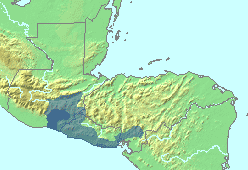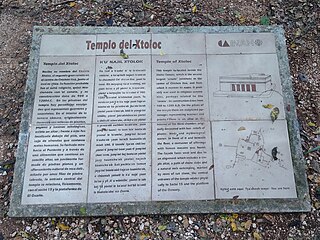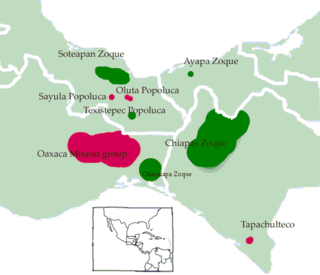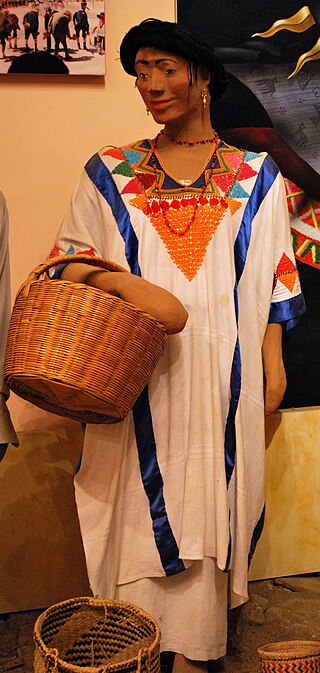Related Research Articles
The Huastec or Téenek are an indigenous people of Mexico, living in the La Huasteca region including the states of Hidalgo, Veracruz, San Luis Potosí and Tamaulipas concentrated along the route of the Pánuco River and along the coast of the Gulf of Mexico.

Mesoamerican languages are the languages indigenous to the Mesoamerican cultural area, which covers southern Mexico, all of Guatemala, Belize, El Salvador, and parts of Honduras, Nicaragua and Costa Rica. The area is characterized by extensive linguistic diversity containing several hundred different languages and seven major language families. Mesoamerica is also an area of high linguistic diffusion in that long-term interaction among speakers of different languages through several millennia has resulted in the convergence of certain linguistic traits across disparate language families. The Mesoamerican sprachbund is commonly referred to as the Mesoamerican Linguistic Area.

The Oto-Manguean or Otomanguean languages are a large family comprising several subfamilies of indigenous languages of the Americas. All of the Oto-Manguean languages that are now spoken are indigenous to Mexico, but the Manguean branch of the family, which is now extinct, was spoken as far south as Nicaragua and Costa Rica. Oto-Manguean is widely viewed as a proven language family.

The Mazatecan languages are a group of closely related indigenous languages spoken by some 200,000 people in the area known as the Sierra Mazateca, which is in the northern part of the state of Oaxaca in southern Mexico, as well as in adjacent areas of the states of Puebla and Veracruz.

Xinca is a small extinct family of Mesoamerican languages, formerly regarded as a single language isolate, once spoken by the indigenous Xinca people in southeastern Guatemala, much of El Salvador, and parts of Honduras.

The Constitution of Mexico does not declare an official language; however, Spanish is the de facto national language spoken by over 99% of the population making it the largest Spanish speaking country in the world. Due to the cultural influence of the United States, American English is widely understood, especially in border states and tourist regions, with a hybridization of Spanglish spoken. The government also recognizes 63 indigenous languages spoken in their communities out of respect, including Nahuatl, Mayan, Mixtec, etc.

The Mixe–Zoque languages are a language family whose living members are spoken in and around the Isthmus of Tehuantepec, Mexico. The Mexican government recognizes three distinct Mixe–Zoquean languages as official: Mixe or ayook with 188,000 speakers, Zoque or o'de püt with 88,000 speakers, and the Popoluca languages of which some are Mixean and some Zoquean with 69,000 speakers. However, the internal diversity in each of these groups is great. Glottolog counts 19 different languages, whereas the current classification of Mixe–Zoquean languages by Wichmann (1995) counts 12 languages and 11 dialects. Extinct languages classified as Mixe–Zoquean include Tapachultec, formerly spoken in Tapachula, along the southeast coast of Chiapas.

Chocho is a language of the Popolocan branch of the Oto-Manguean language family spoken in Mexico in the following communities of Oaxaca: San Miguel Chicahua, Teotongo, San Miguel Huautla, Santa Magdalena Jicotlán, San Pedro Nopala, San Miguel Tequixtepec, San Francisco Teopan, Ocotlán, Santa María Nativitas, San Juan Bautista Coixtlahuaca, and San Miguel Tulancingo. Chocho is spoken by 770 speakers.
Ixcatec is a language spoken by the people of the Mexican village of Santa María Ixcatlan, in the northern part of the state of Oaxaca. The Ixcatec language belongs to the Popolocan branch of the Oto-Manguean language family. It is believed to have been the second language to branch off from the others within the Popolocan subgroup, though there is a small debate over the relation it has to them.

The Oto-Pamean languages are a branch of the Oto-Manguean languages that includes languages of the Otomi-Mazahua, Matlatzinca, and Pamean language groups all of which are spoken in central Mexico. Like all Oto-Manguean languages, the Oto-Pamean languages are tonal languages, though most have relatively simple tone systems. Unlike many Oto-Manguean languages that tend towards an isolating typology, they are morphologically complex headmarking languages with complex systems of conjugational classes both for verbs and nouns, and in the Pamean languages there are highly complex patterns of suppletion.
Popoluca is a Nahuatl term for various indigenous peoples of southeastern Veracruz and Oaxaca. Many of them speak languages of the Mixe–Zoque family. Others speak the unrelated Mazatecan languages, in which case the name in English and Spanish is generally spelled Popoloca.

Popoloca is an indigenous Mexican cluster of languages of the Popolocan branch of the Oto-Manguean language family, closely related to Mazatec. They are spoken by 17,000 people in Puebla state, Mexico, near Tehuacán.

The Mixe languages are languages of the Mixean branch of the Mixe–Zoquean language family indigenous to southern Mexico. According to a 1995 classification, there are seven of them. The four that are spoken in Oaxaca are commonly called Mixe while their two relatives spoken in Veracruz are commonly called "Popoluca", but sometimes also Mixe. This article is about the Oaxaca Mixe languages, which their speakers call Ayöök, Ayuujk, Ayüük or Ayuhk.
Sayula Popoluca, also called Sayultec, is a Mixe language spoken by around 5,000 indigenous people in and around the town of Sayula de Alemán in the southern part of the state of Veracruz, Mexico. Almost all published research on the language has been the work of Lawrence E. Clark of the Summer Institute of Linguistics. More recent studies of Sayula Popoluca have been conducted by Dennis Holt (lexico-semantics) and Richard A. Rhodes, but few of their findings have been published.
The Chochos are an indigenous people of the Mexican state of Oaxaca.

Totozoquean is a proposed language family of Mesoamerica, originally consisting of two well-established genetic groupings, Totonacan and Mixe–Zoque. The erstwhile isolate Chitimacha was later proposed to be a member. The closest relatives of Totozoquean may be the Huavean languages.

The Indigenous people of Oaxaca are descendants of the inhabitants of what is now the state of Oaxaca, Mexico, who were present before the Spanish invasion. Several cultures flourished in the ancient region of Oaxaca from as far back as 2000 BC, of whom the Zapotecs and Mixtecs were perhaps the most advanced, with complex social organization and sophisticated arts.

The state of Oaxaca, Mexico has a total population of about 3.5 million, with women outnumbering men by 150,000 and about 60% of the population under the age of 30. It is ranked tenth in population in the country. Fifty three percent of the population lives in rural areas. Most of the state’s population growth took place between 1980 and 1990. Life expectancy is 71.7 for men and 77.4 for women, just under the national average. Births far outpace deaths. In 2007, there were 122,579 births and 19,439 deaths. Approximately 85% profess the Catholic faith.

The Mixtecan languages constitute a branch of the Oto-Manguean language family of Mexico. They include the Trique languages, spoken by about 24,500 people; Cuicatec, spoken by about 15,000 people; and the large expanse of Mixtec languages, spoken by about 511,000 people. The relationship between Trique, Cuicatec, and Mixtec, is an open question. Unpublished research by Terrence Kaufman in the 1980s supported grouping Cuicatec and Mixtec together.
Proto-Mixe–Zoquean or Proto-Mixe–Zoque is a language that language scholars and Mesoamerican historians believe was spoken on the Isthmus of Tehuantepec during the Initial Formative Period. Wichmann (1995) has reconstructed nearly 600 Proto-Mixe–Zoquean lexical items.
References
- ↑ Fernández de Miranda, María Teresa. 1951. Reconstrucción del protopopoloca. Revista Mexicana de Estudios Antropológicos 12: 61–93.